The Gerbera is a genus of ornamental plants from the sunflower family, Asteraceae. It was discovered in 1884 near Barberton, South Africa, by Scotsman Robert Jameson. The flowers scientific name, Gerbera jamesonii, is from the name of its founder, the meaning of its common name draws from German naturalist Traugott Gerber.
 In England, around 1890 breeding programs were created to enhance the flowers quality and color variations. The Gerbera Daisies popularity soon traveled to growers in the Netherlands which, along with Columbia, is the primary distributor of the flowers today. The Gerbera currently ranks as the fifth most popular flower in the world and is used mostly for cut arrangements. The gerbera is also widely used as a model organism when studying flower formation. The Gerbera species bear a large capitulum with beautiful 2 lipped ray florets in a wide variety of colors. The capitulum is a type of flower head where the bracts are located under the basis. On a Gerbera Daisy the capitulum has the appearance of a single flower, is actually composed of hundreds of individual flowers. The morphology of these flowers depends where they are located in the capitulum. Gerberas possess composite flowers with disk and ray florets. The central disk contains the disk florets. Surrounding the central disk are the intermediate, trans florets. The outermost petals are the ray florets.
In England, around 1890 breeding programs were created to enhance the flowers quality and color variations. The Gerbera Daisies popularity soon traveled to growers in the Netherlands which, along with Columbia, is the primary distributor of the flowers today. The Gerbera currently ranks as the fifth most popular flower in the world and is used mostly for cut arrangements. The gerbera is also widely used as a model organism when studying flower formation. The Gerbera species bear a large capitulum with beautiful 2 lipped ray florets in a wide variety of colors. The capitulum is a type of flower head where the bracts are located under the basis. On a Gerbera Daisy the capitulum has the appearance of a single flower, is actually composed of hundreds of individual flowers. The morphology of these flowers depends where they are located in the capitulum. Gerberas possess composite flowers with disk and ray florets. The central disk contains the disk florets. Surrounding the central disk are the intermediate, trans florets. The outermost petals are the ray florets.
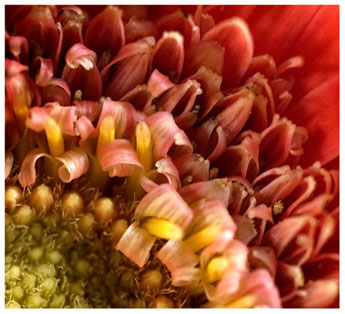
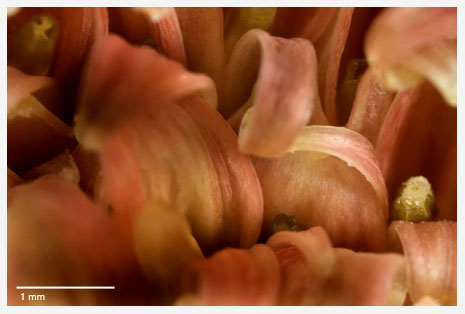



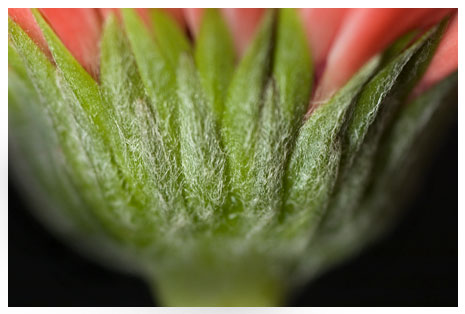
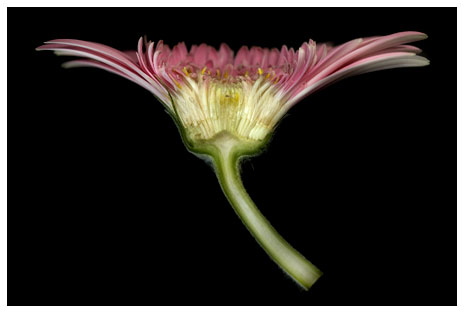

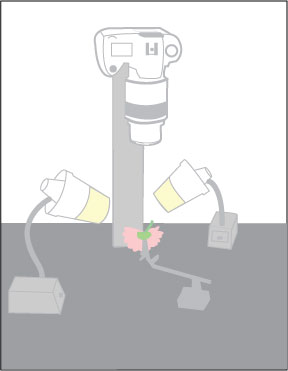 A Nikon D70 camera was used in all of these images. Using both 60mm and 105mm macro lenses provided edge to edge sharpness when photographing these flowers. To obtain a more magnified images, especially when shooting the males stamen, Nikon bellows and a 38mm thimble lens was used. Two Tensor lights with styrofoam cups for diffusion were used for lighting. One light was placed on either side of the flower in order to crate uniform light over the entire flower (see diagram to the right). Exposure times ranged anywhere from 10 seconds to 1 second depending on which magnification being shot. Third arms and modeling clay were used to keep the flower in place. A copy stand held the camera above the flower and helped to minimize vibration.
A Nikon D70 camera was used in all of these images. Using both 60mm and 105mm macro lenses provided edge to edge sharpness when photographing these flowers. To obtain a more magnified images, especially when shooting the males stamen, Nikon bellows and a 38mm thimble lens was used. Two Tensor lights with styrofoam cups for diffusion were used for lighting. One light was placed on either side of the flower in order to crate uniform light over the entire flower (see diagram to the right). Exposure times ranged anywhere from 10 seconds to 1 second depending on which magnification being shot. Third arms and modeling clay were used to keep the flower in place. A copy stand held the camera above the flower and helped to minimize vibration.
Information from http://en.wikipedia.org/wiki/Gerbera and www.gerbera.org
Return to index of articles
by students on the 'Principles and techniques of photomacrography'
course, November 2007,
Biomedical Photographic Communications (BPC)
program at the Rochester Institute of Technology (RIT).
Article hosted on Micscape Magazine (Microscopy-UK).